Project Highlights | |
|---|---|
| Location | Northern Saskatchewan, Canada |
| Ownership | 100% |
| Status | Athabasca Basin uranium exploration project with +30 km strike of prospective EM conductors and uranium intercepts in first-pass drilling. Under option to Aero Energy Ltd. |
| Commodity | Uranium |
The 100% owned Murmac Uranium Project has been confirmed to have potential for high-grade unconformity-related, basement-hosted uranium deposits in a setting similar to other discoveries on the margin of the Athabasca Basin.
In 2022 Fortune Bay augmented the historical exploration datasets (captured from assessment reports) with high-quality VTEMTM and ground gravity survey, and completed a maiden drill program of 15 holes (3,168 m). Anomalous uranium (>100 ppm U) was intersected in six of the holes, up to a maximum individual assay of 0.18% U3O8. Shallow, elevated uranium in drill core is associated with “pathfinder” elements (typical of high-grade Athabasca deposits) and is hosted in prospective highly-graphitic units with favorable brittle structures and alteration.
The drill results confirm that an Athabasca Basin unconformity-style mineralizing system has been active at Murmac. Follow-up of newly intersected mineralization is warranted, as well as drill testing of numerous geophysical and structural targets.

Project Summary
The Project includes 17 mineral claims covering an area of 10,363 hectares and is located 15 kilometres south of Uranium City. The Project is endowed with established infrastructure including existing roads directly to the Project area, active hydro-powerline to within 2 km of the Project boundary, and nearby facilities and an airport at Uranium City.
The Murmac Project includes 7 recently staked claims in 2023 that have added 5,052 hectares to the Project area (a 95% increase from 2022). Combined with the Strike Uranium Project, the Project gives Fortune Bay a dominant land position of the electromagnetic (“EM”) conductors in Canada’s original uranium mining district.
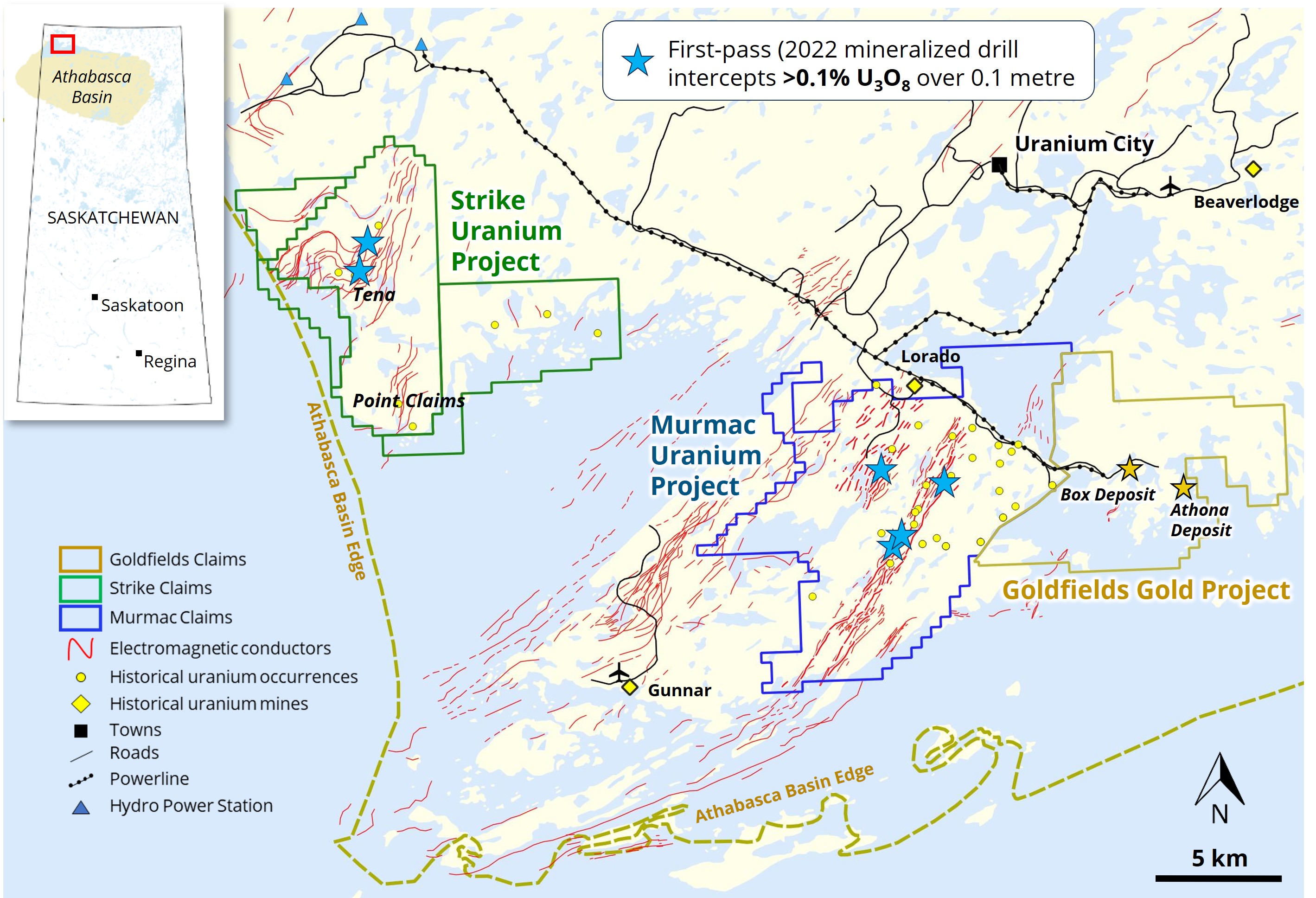
Exploration Potential – an Untested Exploration Model
The historical exploration information presented here has been compiled from reports obtained from the Saskatchewan Mineral Assessment Database, please review the Technical Disclosure section at the bottom of this page for more information and cautionary notes.
Historical exploration at Murmac focussed overwhelmingly on surface prospecting of exposed outcrop. Murmac hosts +30 km strike length of prospective electromagnetic (“EM”) conductors (graphite- and sulphide-rich lithological units), which are soft and weather preferentially, forming pronounced negative topographical features (valleys) infilled with cover sediments and lakes. The prospective EM conductors units are not visible at surface and have never been systematically explored, despite them being the preferred hosts for Athabasca Basin high-grade uranium deposits.
The geological setting, historical datasets and current drill results support the Project’s potential for Athabasca Basin high-grade unconformity-related, basement-hosted uranium deposits in accordance with current exploration models for these types of deposits, with key exploration criteria identified below:
Significant Uranium Endowment
- The uranium endowment of the Project is well established through historical work until the 1980’s which identified numerous high-grade (> 1% U3O8) uranium occurrences primarily through prospecting and trenching. These historical occurrences are dominantly fault-hosted mineralization occurring in outcrop and boulders, many of which were verified by Fortune Bay in Fall, 2022.
- Nearby significant past uranium producers include the Lorado, Gunnar and Beaverlodge (Eldorado) mines.
- Approximately 250 historical drill holes, completed between 1947 and 1987, are documented within the Project area which were largely focused on the known uranium occurrences, and included shallow, high-grade drill intersections. Historical drilling did not systematically target the prospective EM conductors, or fault/conductor intersections, but rather targeted down-dip extensions of fault-hosted mineralization identified at surface.
Favorable Host Rocks
- Airborne VTEMTM survey has identified three main EM conductor packages covering a combined strike length of over 30 km. These conductors have been confirmed to represent graphite-rich metasediments, which are known to provide favorable settings for the formation of Athabasca Basin high-grade, unconformity-related deposits.
- Abundant quartzites (highly resistant) are present along the strike of and in contact with the conductive units (very soft), providing favorable competency contrasts to create prospective dilational settings.
- The Athabasca Basin margin is located approximately five kilometres to the south of the Project, indicating vertical proximity to the basal unconformity (now eroded) and good preservation potential for basement-hosted mineralization. The basal unconformity of the Martin Group transects the northern part of the Project.
- Uranium mineralization has been documented along the Athabasca Basin margin associated with the southwest extension of the Murmac conductor package, including the Stewart, Johnston and Sampson Island showings.
Murmac Geology and Uranium Occurrence Highlights
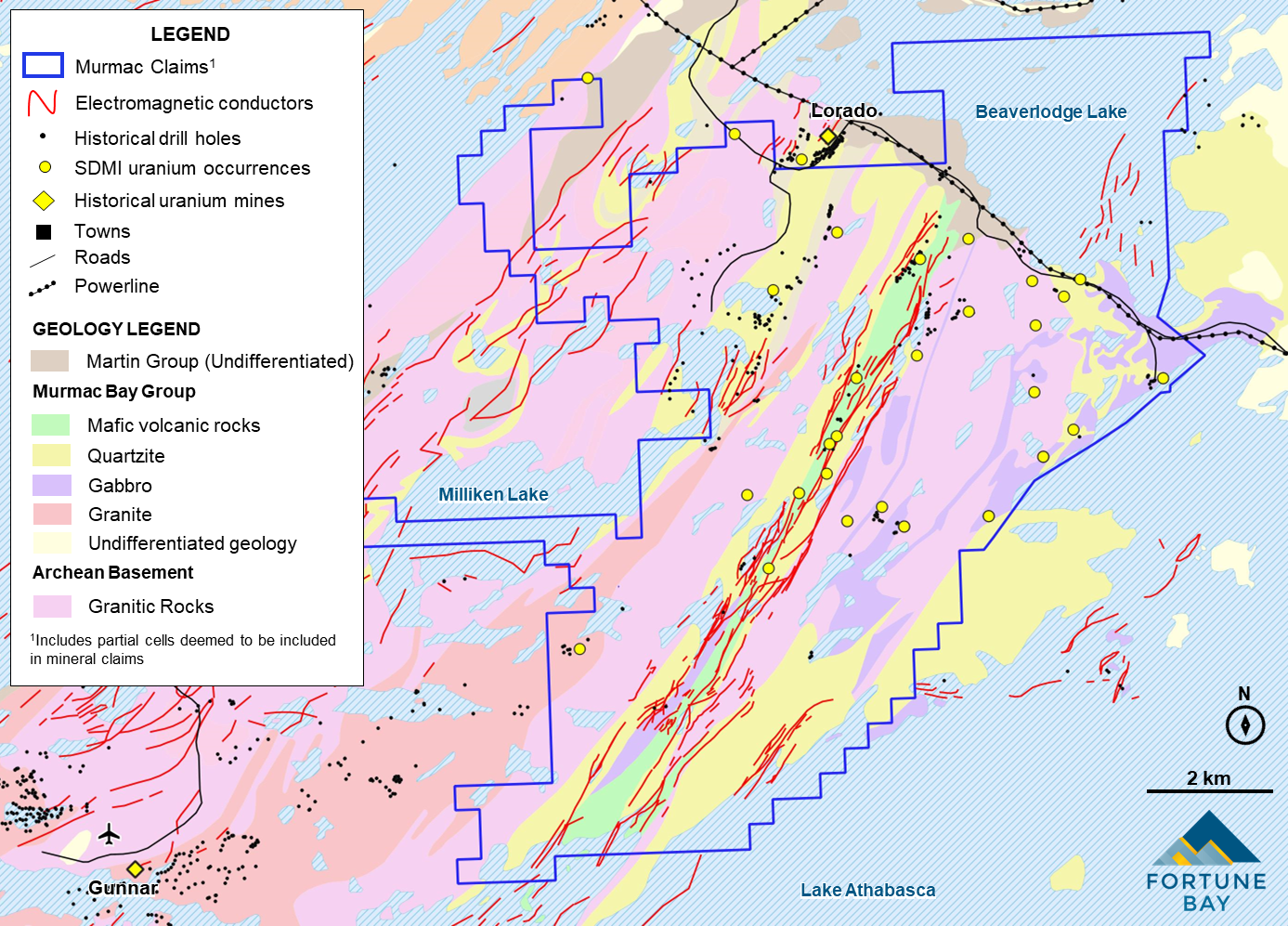
Work Completed by Fortune Bay
VTEMTM Survey
A 430-line kilometer VTEMTM survey was carried out by Geotech Ltd. (“Geotech”, of Ontario, Canada) on behalf of Fortune Bay between April 8th to April 20th, 2022. This survey covered the entire Murmac Project area (prior to staking of additional ground in 2023) with lines at 200 m spacing, oriented 120°/300° on a true north azimuth. Three prominent conductor corridors (+30 km strike length) were identified and, from west to east, have been named the Pitchvein, Armbruster and Howland conductor packages or corridors. These are all well defined in the conductance line data and have been mapped in with a high level of spatial confidence and have been targeted in current exploration activities. Additional discrete conductors to the northwest of Pitchvein have not yet been targeted.
Murmac VTEMTM Survey and Targeted Conductors
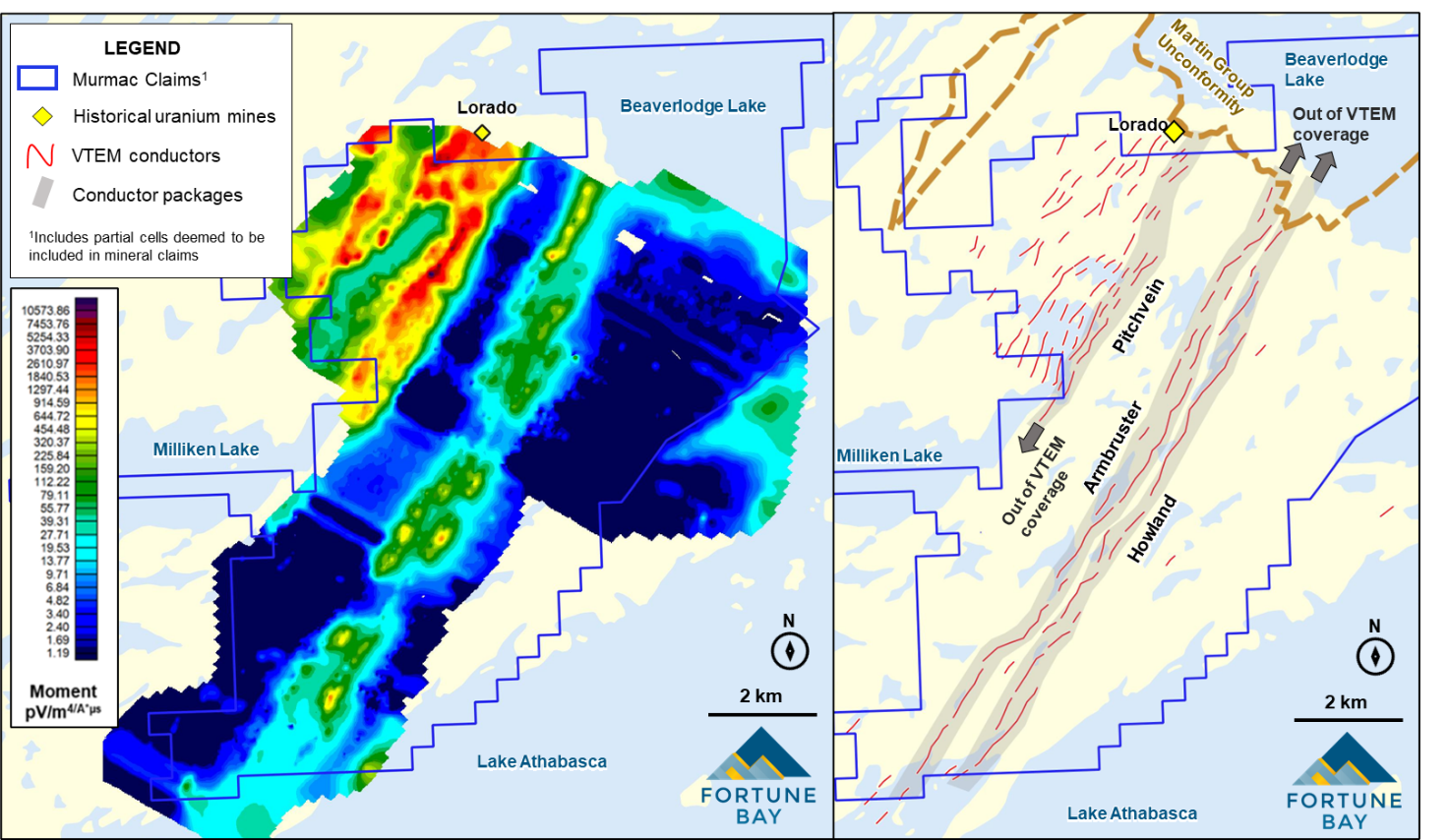
Ground Gravity Survey
The three targeted EM conductor corridors, and additional conductor traces to the northwest of Pitchvein, were targeted for ground gravity survey in winter, 2022. All work was carried out by MWH Geo-Surveys Ltd. of Vernon, BC. All survey work was carried out at a station spacing of 50 m along lines at a 200 m spacing, oriented on a true north azimuth 120°/300°. A total of 2,752 survey stations were completed. These data were compiled with VTEMTM survey data and were used to support drill targeting for the 2022 drill program.
Murmac Ground Gravity Survey
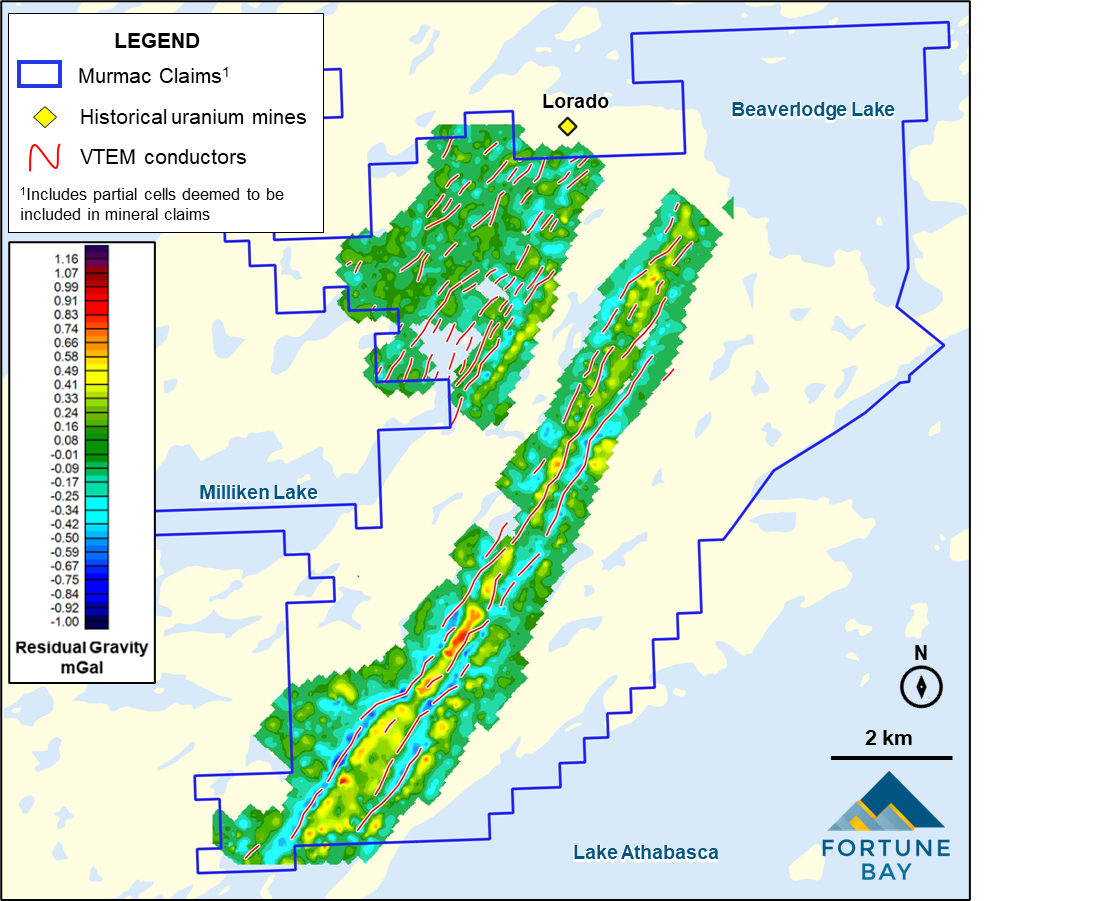
Core Drilling
Helicopter-supported core drilling (NQ2 diameter) was carried out in Summer 2022 by Team Drilling LP ("Team") of Saskatoon, Saskatchewan using a single Zinex A5 drill rig. Core was logged in detail, and samples were collected to test radioactive intersections, to test interesting alteration / structural features and to provide a broad background characterization of the various lithologies intersected. Radioactive sections were tested with continuous sampling of any intervals exceeding 300 cps as measured on a Super-SPEC RS-125 Scintillometer. Sample intervals of 10 cm were used to better characterize narrow radioactive intervals and features of interest and to minimize dilution of the geochemical features and pathfinder associations. Sample length was extended as necessary to reflect the nature and variability of the targeted interval, up to a maximum of 50 cm. A total of 462 drill core geochemistry samples were collected.
A summary of first-pass (2022) core drilling results as follows:
- Elevated concentrations of uranium (>100 ppm) in 6 of the 15 drill holes, on all 3 conductors, with highlights as follows:
- Drill hole M22-002: 0.18% U3O8 from 82.0 to 82.1 m
- Drill hole M22-012: 0.17% U3O8 from 102.2 to 102.3 m
- Drill hole M22-013: Broad 13 m zone of intermittent uranium mineralization, including 347 ppm U from 30.8 to 31.4 m, 205 ppm U from 35.9 to 36.9 m, and 448 ppm U from 44.2 to 44.5 m
- Drill hole M22-014: 241 ppm U over 3.0 m from 36.9 to 39.9 m
- Drill hole M22-015: 0.12% U3O8 from 158.2 to 158.3 m, within 503 ppm U from 158.1 to 158.3 m. Plus 122 ppm U from 161.2 to 161.5 m and 219 ppm U from 163.3 to 163.8 m
- Strongly graphitic pelites were intersected in all holes with the single exception of M22-009 (tested cross-fault offset)
- Graphitic units are associated with favorable structure and alteration
- Anomalous concentrations of "pathfinder" elements typically associated with Athabasca Basin unconformity-style uranium mineralization
- Elevated uranium intersections are shallow, between 20 and 150 m below surface
Murmac 2022 Summer Drilling Highlights
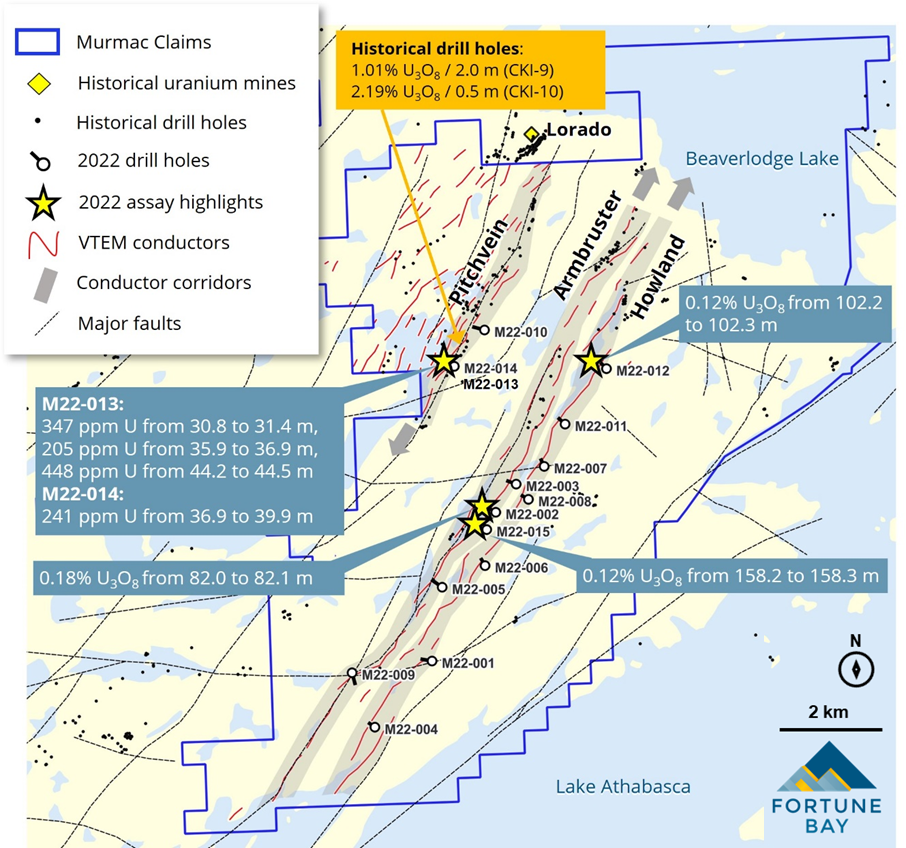
Verification Field Prospecting and Geochemical Sampling
The Murmac Property hosts numerous historical uranium assay and scintillometer anomalies, typically associated with narrow, fault-hosted mineralization in exposed rocks. The mineralization model targeted by Fortune Bay at Murmac is high-grade Athabasca Basin unconformity-related, basement-hosted uranium associated with graphite-rich units (conductors). These rocks are typically soft, and at Murmac they are not visible at surface, lying within topography lows (valleys), covered by glacial sediment and shallow lakes. A prospecting program was carried out in Fall 2022 to verify historical occurrences, evaluate geophysical/structural target locations and to prospect conductor valley edges in selected areas. A total of 179 samples were collected during prospecting.
All historical occurrences (captured from assessment reports) visited were verified through field observation and sampling, and were confirmed to be related to hematized faults in outcrop, highlighting a significant association of uranium with several faults that cross-cut the Armbruster and Howland conductor corridors. These fault and conductor intersections present compelling targets for drill testing. A single boulder assaying at 8.82% U3O8 was discovered, confirming the historically noted presence of these types of occurrences. Closely-spaced (~100m) rock grab samples along conductor valley hanging- and footwalls demonstrated subtle elevations in pathfinder elements that provide further support for drill-testing of geophysical/structural targets in these locations. Additional geochemical prospecting of this nature has been incorporated into forward work plans to assist with further drill target generation and prioritization.
Murmac Fall 2022 Prospecting
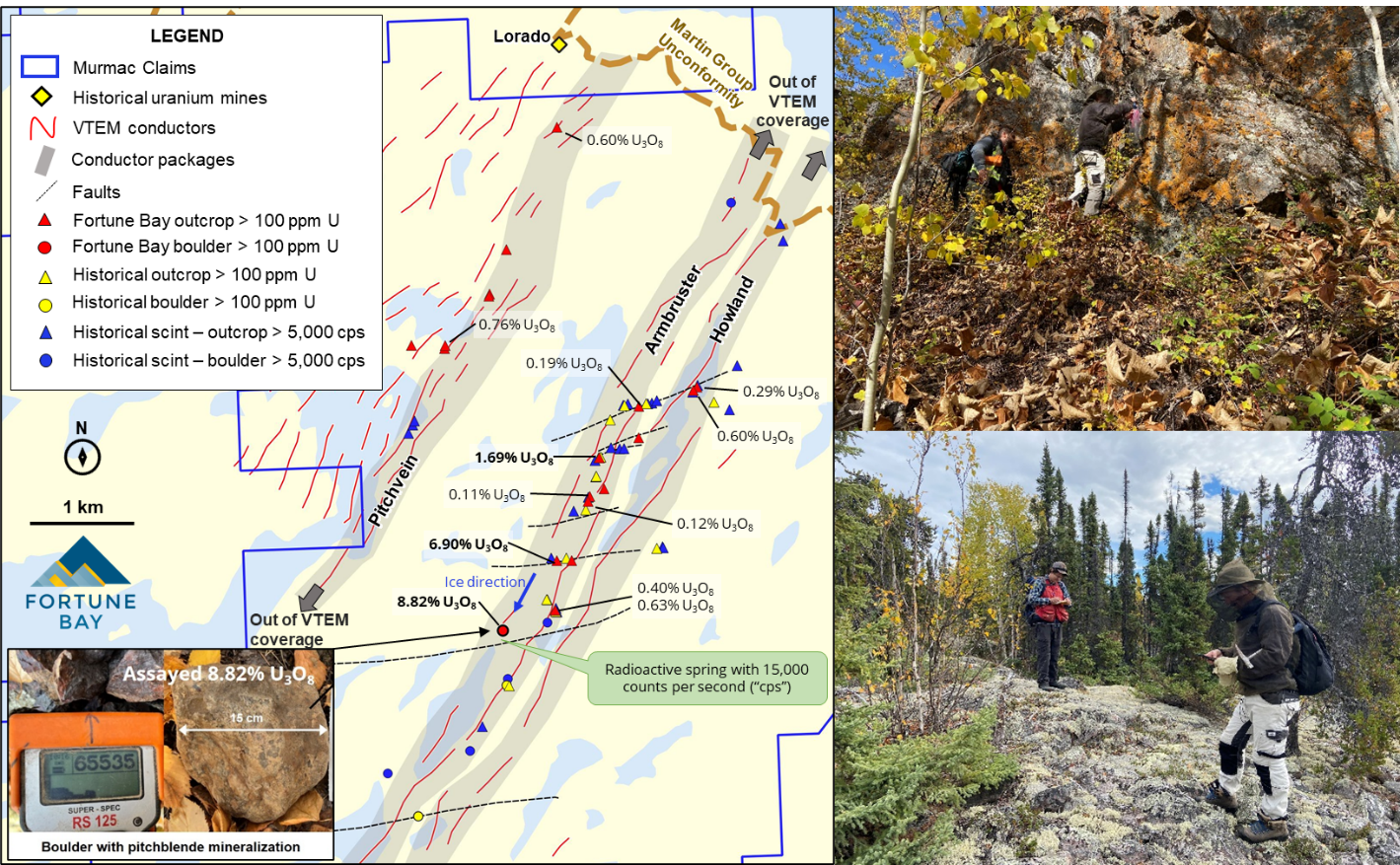
Future Drilling
Encouraging results, particularly in drill holes M22-013/M22-014, M22-002, M22-012 and M22-015 warrant follow-up drill testing along strike. In addition, Fortune Bay has identified 28 targets that warrant drill testing. These include targets in the northern extensions of Armbruster and Howland that are in close proximity to significant off-conductor fault-hosted mineralization present in outcrop on valley edges (granite and quartzite hanging- and footwalls).
Murmac Untested Structural/Geophysical Targets
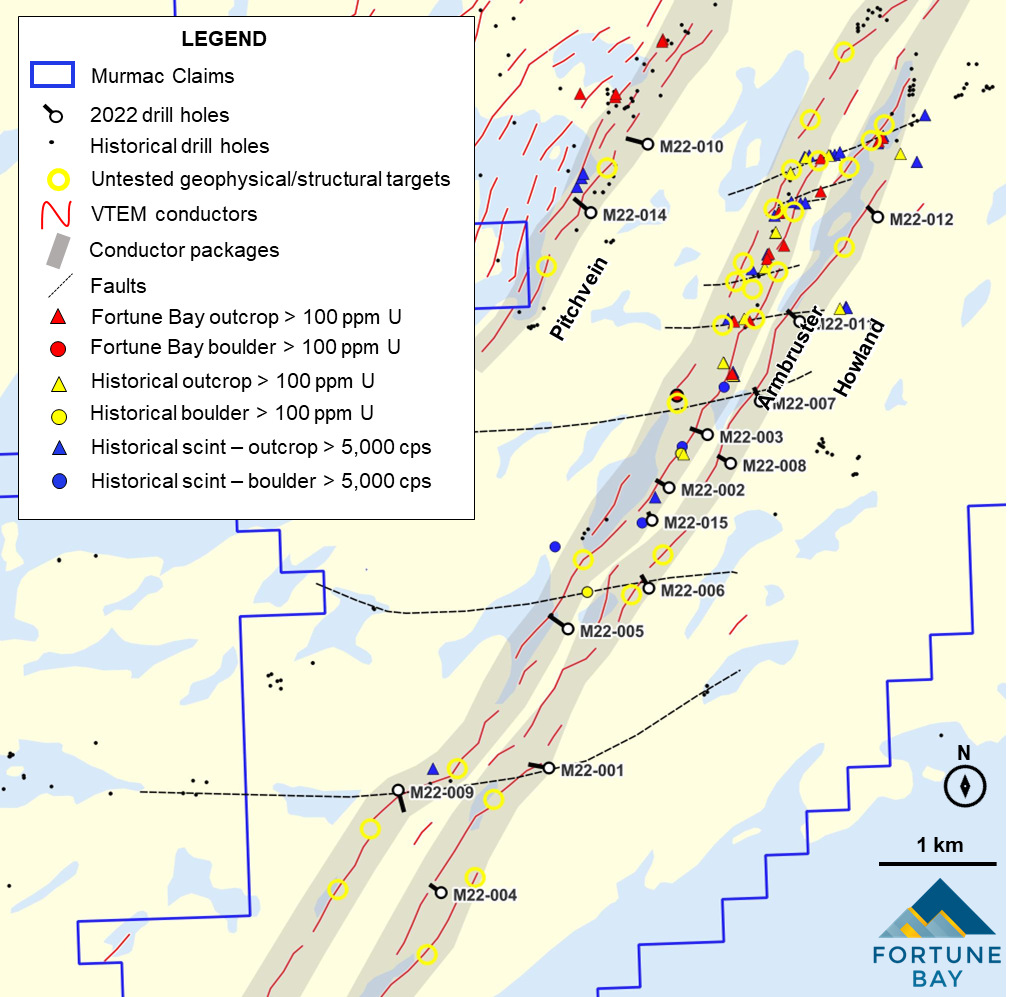
Sampling, Analysis and Data Verification
All samples were submitted to the Saskatchewan Research Council (“SRC”) Geoanalytical Laboratories (ISO/IEC 17025:2005 accredited) for multi-element characterization and uranium assay. Samples are screened upon receipt by SRC, and samples with significantly elevated radioactivity were identified and separated out for the SRC “ICP1” multi-element uranium exploration package. Analysis of the remaining samples was carried out through the SRC “ICP-MS2” basement exploration package. Sample preparation for all samples included drying, jaw crushing to 60% passing -2 mm, and pulverizing to 90% passing -106 microns.
The ICP1 package includes ICP-OES on a total digestion. The ICP-MS2 package consists of three separate analyses, including (1) ICP-MS on a partial digestion, (2) ICP-OES for major and minor elements on a total digestion and (3) and ICP-MS analysis for trace elements on the total digestion. Partial digestions are performed on an aliquot of sample pulp, which is digested in a mixture of concentrated nitric: hydrochloric acid (HNO3:HCl) in a test tube in a hot water bath, and then diluted using deionized water. Total digestions are performed on an aliquot of sample pulp. The aliquot is digested to dryness in a Teflon tube within a hot block digestion system using a mixture of concentrated HF:HNO3:HCIO4. The residue is dissolved in dilute HNO3. Additional analysis for Boron content was obtained for all samples through NaO2/NaCO3 fusion followed by ICP-OES.
QAQC for sample processing included insertion of Blank certified reference material (“CRM”) samples by Fortune Bay at a rate of 1 for every 20 samples, as well as an internal QAQC process by SRC, including regular repeat analyses and insertion of CRM multi-element, uranium and boron standards. All QAQC results were reviewed by Fortune Bay and are considered to confirm that the analyses are of high quality and are sufficiently well constrained to use for the purpose of exploration.
Technical Disclosure
The historical exploration information presented here has been compiled from reports obtained from the Saskatchewan Mineral Assessment Database. Unless otherwise stated, the historical results have not been verified and there is a risk that any future confirmation work and exploration may produce results that substantially differ from the historical results. The Company considers these results relevant to assess the mineralization and economic potential of the property.
Qualified Person
The technical and scientific information on this webpage has been reviewed and approved by Gareth Garlick, P.Geo., Technical Director of the Company, who is a Qualified Person as defined by NI 43-101. Mr. Garlick is an employee of Fortune Bay and is not independent of the Company under NI 43-101.
Cautionary Statements
Information set forth on this webpage may contain forward-looking statements that are based on assumptions as of the date of posting. The reader is referred to the cautionary language contained within the respective Project’s News Releases, in addition to this website’s Terms of Use specifically including Forward Looking Statements.
